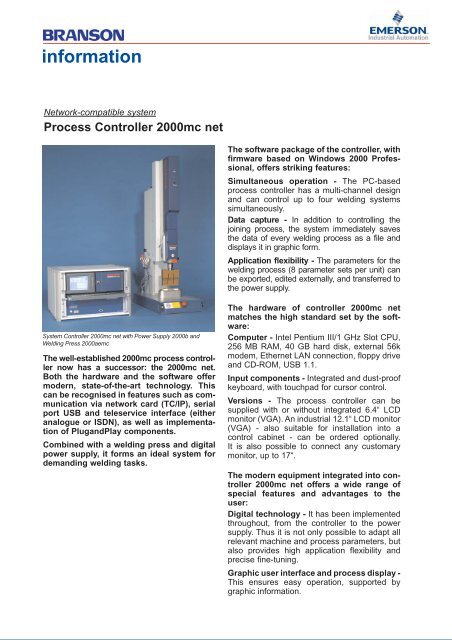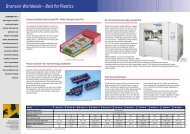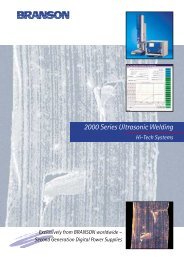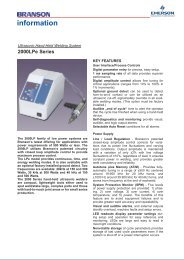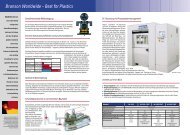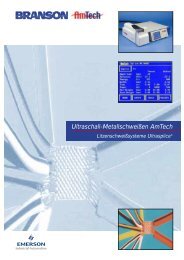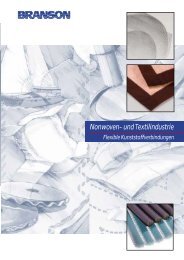Process Controller 2000mc net
Process Controller 2000mc net
Process Controller 2000mc net
You also want an ePaper? Increase the reach of your titles
YUMPU automatically turns print PDFs into web optimized ePapers that Google loves.
information<br />
Network-compatible system<br />
<strong>Process</strong> <strong>Controller</strong> <strong>2000mc</strong> <strong>net</strong><br />
The software package of the controller, with<br />
firmware based on Windows 2000 Professional,<br />
offers striking features:<br />
Simultaneous operation - The PC-based<br />
process controller has a multi-channel design<br />
and can control up to four welding systems<br />
simultaneously.<br />
Data capture - In addition to controlling the<br />
joining process, the system immediately saves<br />
the data of every welding process as a file and<br />
displays it in graphic form.<br />
Application flexibility - The parameters for the<br />
welding process (8 parameter sets per unit) can<br />
be exported, edited externally, and transferred to<br />
the power supply.<br />
System <strong>Controller</strong> <strong>2000mc</strong> <strong>net</strong> with Power Supply 2000b and<br />
Welding Press 2000aemc<br />
The well-established <strong>2000mc</strong> process controller<br />
now has a successor: the <strong>2000mc</strong> <strong>net</strong>.<br />
Both the hardware and the software offer<br />
modern, state-of-the-art technology. This<br />
can be recognised in features such as communication<br />
via <strong>net</strong>work card (TC/IP), serial<br />
port USB and teleservice interface (either<br />
analogue or ISDN), as well as implementation<br />
of PlugandPlay components.<br />
Combined with a welding press and digital<br />
power supply, it forms an ideal system for<br />
demanding welding tasks.<br />
The hardware of controller <strong>2000mc</strong> <strong>net</strong><br />
matches the high standard set by the software:<br />
Computer - Intel Pentium III/1 GHz Slot CPU,<br />
256 MB RAM, 40 GB hard disk, external 56k<br />
modem, Ether<strong>net</strong> LAN connection, floppy drive<br />
and CD-ROM, USB 1.1.<br />
Input components - Integrated and dust-proof<br />
keyboard, with touchpad for cursor control.<br />
Versions - The process controller can be<br />
supplied with or without integrated 6.4“ LCD<br />
monitor (VGA). An industrial 12.1“ LCD monitor<br />
(VGA) - also suitable for installation into a<br />
control cabi<strong>net</strong> - can be ordered optionally.<br />
It is also possible to connect any customary<br />
monitor, up to 17“.<br />
The modern equipment integrated into controller<br />
<strong>2000mc</strong> <strong>net</strong> offers a wide range of<br />
special features and advantages to the<br />
user:<br />
Digital technology - It has been implemented<br />
throughout, from the controller to the power<br />
supply. Thus it is not only possible to adapt all<br />
relevant machine and process parameters, but<br />
also provides high application flexibility and<br />
precise fine-tuning.<br />
Graphic user interface and process display -<br />
This ensures easy operation, supported by<br />
graphic information.
<strong>Process</strong> <strong>Controller</strong> <strong>2000mc</strong> <strong>net</strong> with Power Supply<br />
Digital Compact DC<br />
Optional Data Management with statistics<br />
package - The powerful access-based program<br />
has been designed for saving, evaluating<br />
and archiving welding data (online/offline), as<br />
well as for integration into company <strong>net</strong>works,<br />
easy data exchange and online support.<br />
Selective deactivation of individual channels<br />
- An advantageous tool for editing parameters<br />
offline and servicing components.<br />
Diverse process control options can be<br />
accessed:<br />
Amplitude and Force Profiling - Both methods<br />
control the joining process, using presets<br />
determined by empirical knowledge. They indirectly<br />
ensure optimal welding conditions, leading<br />
to controlled melting in the welding zone.<br />
In the case of Amplitude Profiling (pat.),<br />
the process controller reduces the amplitude<br />
of the horn after certain set values have<br />
been reached (welding time, distance, energy,<br />
peak power level), consequently reducing the<br />
required plastification energy during the residual<br />
time. Amplitude profiling is suited to amorphous<br />
thermoplastics.<br />
In the case of Force Profiling welding usually<br />
commences with a high energy. Subsequently,<br />
after a preset time interval in the millisecond<br />
range, it is significantly reduced. The energy<br />
being applied to the welding seam is thus<br />
lowered, which leads to controlled melting of<br />
plastic in the joint area. The force profile is<br />
recommended in the case of partially crystalline<br />
thermoplastics.<br />
Energy Mode - Welding with preset energy<br />
level and adjustable threshold monitoring.<br />
Time Mode - Welding with preset time and<br />
adjustable threshold monitoring.<br />
Peak Power Mode - Welding with preset<br />
power level and adjustable threshold<br />
monitoring.<br />
Metal Contact Mode - Welding until metal<br />
contact is achieved and adjustable hold time.<br />
Collapse Distance Mode - The welding distance<br />
is only registered after a reference value<br />
- the preset trigger force - has been reached.<br />
Absolute Distance Mode - The complete<br />
down travel of the fixing tool actuator is<br />
measured.<br />
Optional Ramps - They optimise the force<br />
increase within the welding process.<br />
<strong>Process</strong> <strong>Controller</strong> <strong>2000mc</strong> <strong>net</strong> with external monitor and<br />
Power Supply 2000b<br />
BRANSON ULTRASCHALL · Waldstraße 53-55 · D-63128 Dietzenbach · Telefon (0 60 74) 497-0 · Telefax (0 60 74) 497-199<br />
Inter<strong>net</strong>: www.branson.de · E-mail: info@branson.de<br />
CH Tel. (022) 3 04 83 40, Fax (022) 3 04 83 59 · DK Tel. (032) 51 32 33, Fax (032) 51 51 39 · E Tel. (93) 5 86 05 00, Fax Tel. (93) 5 88 22 58 · F Tel. (01) 41 80 25 50, Fax (01) 46 87 87 29<br />
GB Tel. (01753) 486980, Fax (01753) 486995 · I Tel.(02) 66 08 17.1, Fax (02) 66 08 17 97 · NL Tel. (035) 6 09 81 11, Fax (035) 6 09 81 20<br />
05/04 / Subject to change without notice


